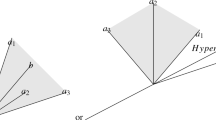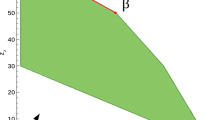Abstract
The goal is to give some theoretical explanation for the efficiency of the simplex method of George Dantzig. Fixing the number of constraints and using Dantzig's self-dual parametric algorithm, we show that the number of pivots required to solve a linear programming problem grows in proportion to the number of variables on the average.
Similar content being viewed by others
References
I. Adler and S. Berenguer, “Random linear programs”, Technical Report ORC 81-4, Operations Research Center, University of California (Berkeley, 1981).
C. Allendoerfer and A. Weil, “The Gauss-Bonnet theorem for Riemannian polyhedra”, Transactions of the American Mathematical Society 53 (1943) 101–129.
K.-H. Borgwardt, “The average number of steps required by the simplex method is polynomial”, to appear in Zeitschrift für Operations Research.
R.W. Cottle and G.B. Dantzig, “Complementary pivot theory of mathematical programming”, in: G.B. Dantzig and A.F. Veinott, Jr., eds., Mathematics of the Decision Sciences, Part 1 (American Mathematical Society, Providence, RI, 1968) pp. 115–136.
G.B. Dantzig, Linear programming and extensions (Princeton University Press, Princeton, NJ, 1963).
G.B. Dantzig, “Expected number of steps of the simplex method for a linear program with a convexity constraint”, Technical Report SOL 80-3, Systems Optimization Laboratory, Department of Operations Research, Stanford University (Stanford, CA, 1980).
B.C. Eaves and H. Scarf, “The solution of systems of piecewise linear equations”, Mathematics of Operations Research 1 (1976) 1–27.
W. Feller, An introduction to probability theory and its applications, 2nd ed., Vol. 1 (Wiley, New York, 1957).
D. Gale, H.W. Kuhn, and A.W. Tucker, “Linear programming and the theory of games”, in: T.C. Koopmans, ed., Activity analysis of production and allocation (Wiley, New York, 1951).
M. Hirsch and S. Smale, “On algorithms for solvingf(x)=0”, Communications on Pure and Applied Mathematics 32 (1979) 281–312.
R. Howe, “Linear complementarity and the degree of mappings”, Cowles Foundation Discussion Paper No. 452, Yale University (New Haven, CT, 1980).
V. Klee and G. Minty, “How good is the simplex algorithm?”, in: O. Shisha, ed., Inequalities III (Academic Press, New York, 1972) pp. 159–175.
T.M. Liebling, “On the number of iterations of the simplex method”, in: R. Henn, H. Künzi, and H. Schubert, eds., Operations Research Verfahren/Methods of Operations Research XVII (1973) 248–264.
L. Lovász, “A new linear programming algorithm—Better or worse than the simplex method?”, The Mathematical Intelligencer 2 (1980) 141–146.
J. May and R. Smith, “Random polytopes: Their definition, generation, and aggregate properties, Mathematical Programming 24 (1982) 39–54.
K.G. Murty, “Computational complexity of complementary pivot methods”, Mathematical Programming Study 7 (1978) 61–73.
M. Shub and S. Smale, “Computational complexity: On the geometry of polynomials and a theory of cost, Part I”, preprint (1982).
S. Smale, “A convergent process of price adjustment and global Newton methods”, Journal of Mathematical Economics 3 (1976) 107–120.
S. Smale, “The fundamental theorem of algebra and complexity theory”, Bulletin of the American Mathematical Society 4 (1981) 1–36.
J. Traub and H. Woźniakowski, “Complexity of linear programming”, Operations Research Letters 1 (1982) 59–62.
P. Wolfe, “The ellipsoid algorithm” (Letter to the Editor), Science 208 (1980) 240–242.
Author information
Authors and Affiliations
Additional information
Supported in part by NSF Grant #MCS-8102262.
Rights and permissions
About this article
Cite this article
Smale, S. On the average number of steps of the simplex method of linear programming. Mathematical Programming 27, 241–262 (1983). https://doi.org/10.1007/BF02591902
Received:
Revised:
Issue Date:
DOI: https://doi.org/10.1007/BF02591902




